Zhichao Sun
LIGM
MIFNet: Learning Modality-Invariant Features for Generalizable Multimodal Image Matching
Jan 20, 2025



Abstract:Many keypoint detection and description methods have been proposed for image matching or registration. While these methods demonstrate promising performance for single-modality image matching, they often struggle with multimodal data because the descriptors trained on single-modality data tend to lack robustness against the non-linear variations present in multimodal data. Extending such methods to multimodal image matching often requires well-aligned multimodal data to learn modality-invariant descriptors. However, acquiring such data is often costly and impractical in many real-world scenarios. To address this challenge, we propose a modality-invariant feature learning network (MIFNet) to compute modality-invariant features for keypoint descriptions in multimodal image matching using only single-modality training data. Specifically, we propose a novel latent feature aggregation module and a cumulative hybrid aggregation module to enhance the base keypoint descriptors trained on single-modality data by leveraging pre-trained features from Stable Diffusion models. We validate our method with recent keypoint detection and description methods in three multimodal retinal image datasets (CF-FA, CF-OCT, EMA-OCTA) and two remote sensing datasets (Optical-SAR and Optical-NIR). Extensive experiments demonstrate that the proposed MIFNet is able to learn modality-invariant feature for multimodal image matching without accessing the targeted modality and has good zero-shot generalization ability. The source code will be made publicly available.
Shape Transformation Driven by Active Contour for Class-Imbalanced Semi-Supervised Medical Image Segmentation
Oct 18, 2024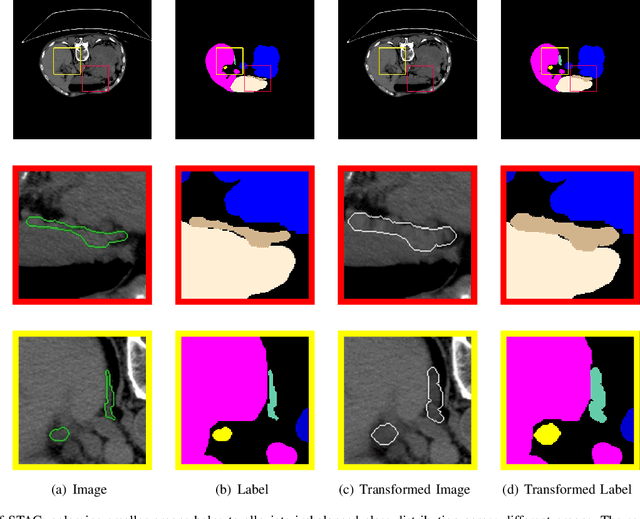
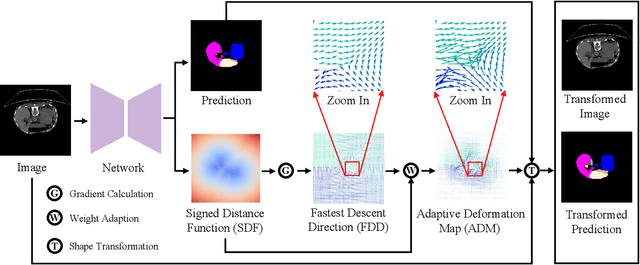
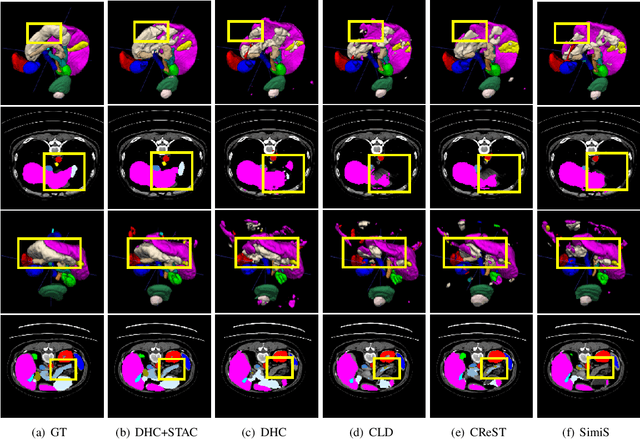
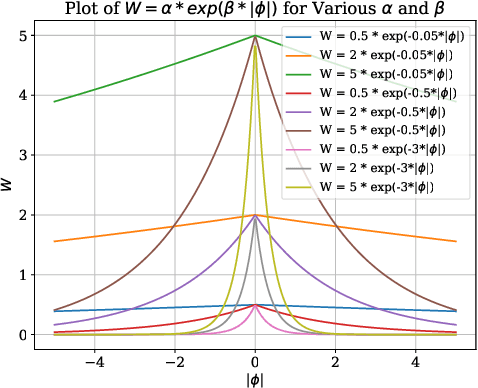
Abstract:Annotating 3D medical images demands expert knowledge and is time-consuming. As a result, semi-supervised learning (SSL) approaches have gained significant interest in 3D medical image segmentation. The significant size differences among various organs in the human body lead to imbalanced class distribution, which is a major challenge in the real-world application of these SSL approaches. To address this issue, we develop a novel Shape Transformation driven by Active Contour (STAC), that enlarges smaller organs to alleviate imbalanced class distribution across different organs. Inspired by curve evolution theory in active contour methods, STAC employs a signed distance function (SDF) as the level set function, to implicitly represent the shape of organs, and deforms voxels in the direction of the steepest descent of SDF (i.e., the normal vector). To ensure that the voxels far from expansion organs remain unchanged, we design an SDF-based weight function to control the degree of deformation for each voxel. We then use STAC as a data-augmentation process during the training stage. Experimental results on two benchmark datasets demonstrate that the proposed method significantly outperforms some state-of-the-art methods. Source code is publicly available at https://github.com/GuGuLL123/STAC.
Spatial-aware Attention Generative Adversarial Network for Semi-supervised Anomaly Detection in Medical Image
May 21, 2024Abstract:Medical anomaly detection is a critical research area aimed at recognizing abnormal images to aid in diagnosis.Most existing methods adopt synthetic anomalies and image restoration on normal samples to detect anomaly. The unlabeled data consisting of both normal and abnormal data is not well explored. We introduce a novel Spatial-aware Attention Generative Adversarial Network (SAGAN) for one-class semi-supervised generation of health images.Our core insight is the utilization of position encoding and attention to accurately focus on restoring abnormal regions and preserving normal regions. To fully utilize the unlabelled data, SAGAN relaxes the cyclic consistency requirement of the existing unpaired image-to-image conversion methods, and generates high-quality health images corresponding to unlabeled data, guided by the reconstruction of normal images and restoration of pseudo-anomaly images.Subsequently, the discrepancy between the generated healthy image and the original image is utilized as an anomaly score.Extensive experiments on three medical datasets demonstrate that the proposed SAGAN outperforms the state-of-the-art methods.
Position-Guided Prompt Learning for Anomaly Detection in Chest X-Rays
May 20, 2024



Abstract:Anomaly detection in chest X-rays is a critical task. Most methods mainly model the distribution of normal images, and then regard significant deviation from normal distribution as anomaly. Recently, CLIP-based methods, pre-trained on a large number of medical images, have shown impressive performance on zero/few-shot downstream tasks. In this paper, we aim to explore the potential of CLIP-based methods for anomaly detection in chest X-rays. Considering the discrepancy between the CLIP pre-training data and the task-specific data, we propose a position-guided prompt learning method. Specifically, inspired by the fact that experts diagnose chest X-rays by carefully examining distinct lung regions, we propose learnable position-guided text and image prompts to adapt the task data to the frozen pre-trained CLIP-based model. To enhance the model's discriminative capability, we propose a novel structure-preserving anomaly synthesis method within chest x-rays during the training process. Extensive experiments on three datasets demonstrate that our proposed method outperforms some state-of-the-art methods. The code of our implementation is available at https://github.com/sunzc-sunny/PPAD.
Dual Structure-Preserving Image Filterings for Semi-supervised Medical Image Segmentation
Dec 12, 2023Abstract:Semi-supervised image segmentation has attracted great attention recently. The key is how to leverage unlabeled images in the training process. Most methods maintain consistent predictions of the unlabeled images under variations (e.g., adding noise/perturbations, or creating alternative versions) in the image and/or model level. In most image-level variation, medical images often have prior structure information, which has not been well explored. In this paper, we propose novel dual structure-preserving image filterings (DSPIF) as the image-level variations for semi-supervised medical image segmentation. Motivated by connected filtering that simplifies image via filtering in structure-aware tree-based image representation, we resort to the dual contrast invariant Max-tree and Min-tree representation. Specifically, we propose a novel connected filtering that removes topologically equivalent nodes (i.e. connected components) having no siblings in the Max/Min-tree. This results in two filtered images preserving topologically critical structure. Applying such dual structure-preserving image filterings in mutual supervision is beneficial for semi-supervised medical image segmentation. Extensive experimental results on three benchmark datasets demonstrate that the proposed method significantly/consistently outperforms some state-of-the-art methods. The source codes will be publicly available.
Noised Autoencoders for Point Annotation Restoration in Object Counting
Dec 12, 2023Abstract:Object counting is a field of growing importance in domains such as security surveillance, urban planning, and biology. The annotation is usually provided in terms of 2D points. However, the complexity of object shapes and subjective of annotators may lead to annotation inconsistency, potentially confusing the model during training. To alleviate this issue, we introduce the Noised Autoencoders (NAE) methodology, which extracts general positional knowledge from all annotations. The method involves adding random offsets to initial point annotations, followed by a UNet to restore them to their original positions. Similar to MAE, NAE faces challenges in restoring non-generic points, necessitating reliance on the most common positions inferred from general knowledge. This reliance forms the cornerstone of our method's effectiveness. Different from existing noise-resistance methods, our approach focus on directly improving initial point annotations. Extensive experiments show that NAE yields more consistent annotations compared to the original ones, steadily enhancing the performance of advanced models trained with these revised annotations. \textbf{Remarkably, the proposed approach helps to set new records in nine datasets}. We will make the NAE codes and refined point annotations available.
CaSAR: Contact-aware Skeletal Action Recognition
Sep 17, 2023



Abstract:Skeletal Action recognition from an egocentric view is important for applications such as interfaces in AR/VR glasses and human-robot interaction, where the device has limited resources. Most of the existing skeletal action recognition approaches use 3D coordinates of hand joints and 8-corner rectangular bounding boxes of objects as inputs, but they do not capture how the hands and objects interact with each other within the spatial context. In this paper, we present a new framework called Contact-aware Skeletal Action Recognition (CaSAR). It uses novel representations of hand-object interaction that encompass spatial information: 1) contact points where the hand joints meet the objects, 2) distant points where the hand joints are far away from the object and nearly not involved in the current action. Our framework is able to learn how the hands touch or stay away from the objects for each frame of the action sequence, and use this information to predict the action class. We demonstrate that our approach achieves the state-of-the-art accuracy of 91.3% and 98.4% on two public datasets, H2O and FPHA, respectively.
System Design and Analysis for Energy-Efficient Passive UAV Radar Imaging System using Illuminators of Opportunity
Oct 01, 2020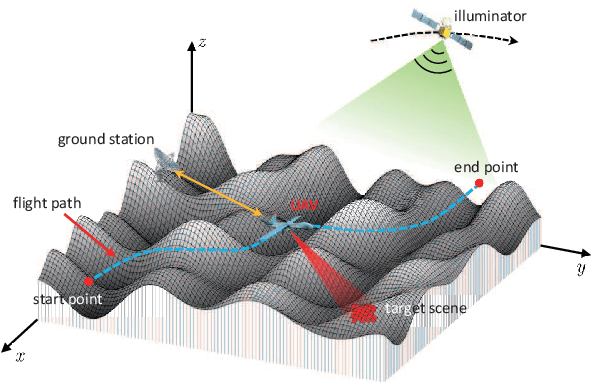
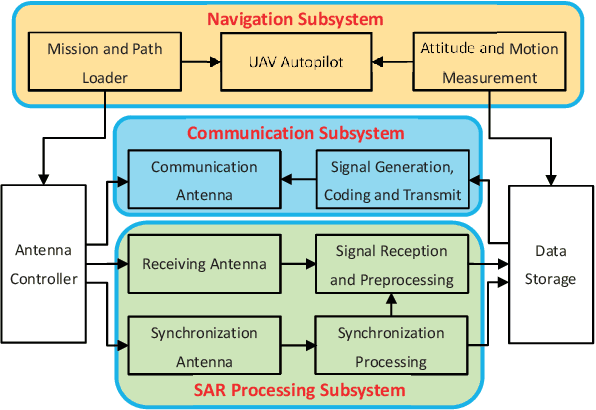
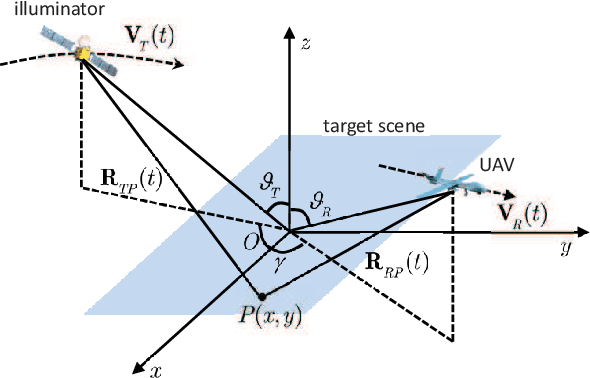
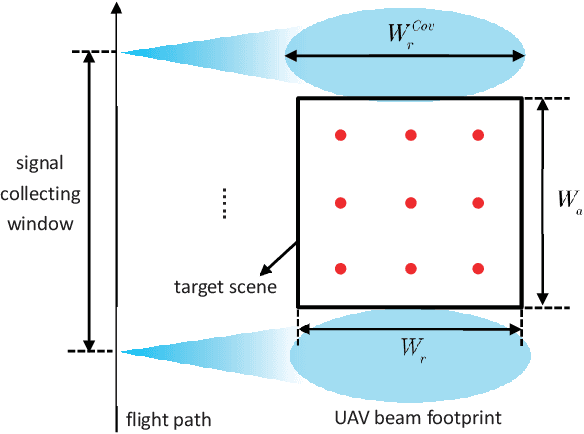
Abstract:Unmanned ariel vehicle (UAV) can provide superior flexibility and cost-efficiency for modern radar imaging systems, which is an ideal platform for advanced remote sensing applications using synthetic aperture radar (SAR) technology. In this paper, an energy-efficient passive UAV radar imaging system using illuminators of opportunity is first proposed and investigated. Equipped with a SAR receiver, the UAV platform passively reuses the backscattered signal of the target scene from an external illuminator, such as SAR satellite, GNSS or ground-based stationary commercial illuminators, and achieves bi-static SAR imaging and data communication. The system can provide instant accessibility to the radar image of the interested targets with enhanced platform concealment, which is an essential tool for stealth observation and scene monitoring. The mission concept and system block diagram are first presented with justifications on the advantages of the system. Then, the prospective imaging performance and system feasibility are analyzed for the typical illuminators based on signal and spatial resolution model. With different illuminators, the proposed system can achieve distinct imaging performance, which offers more alternatives for various mission requirements. A set of mission performance evaluators is established to quantitatively assess the capability of the system in a comprehensive manner, including UAV navigation, passive SAR imaging and communication. Finally, the validity of the proposed performance evaluators are verified by numerical simulations.
 Add to Chrome
Add to Chrome Add to Firefox
Add to Firefox Add to Edge
Add to Edge